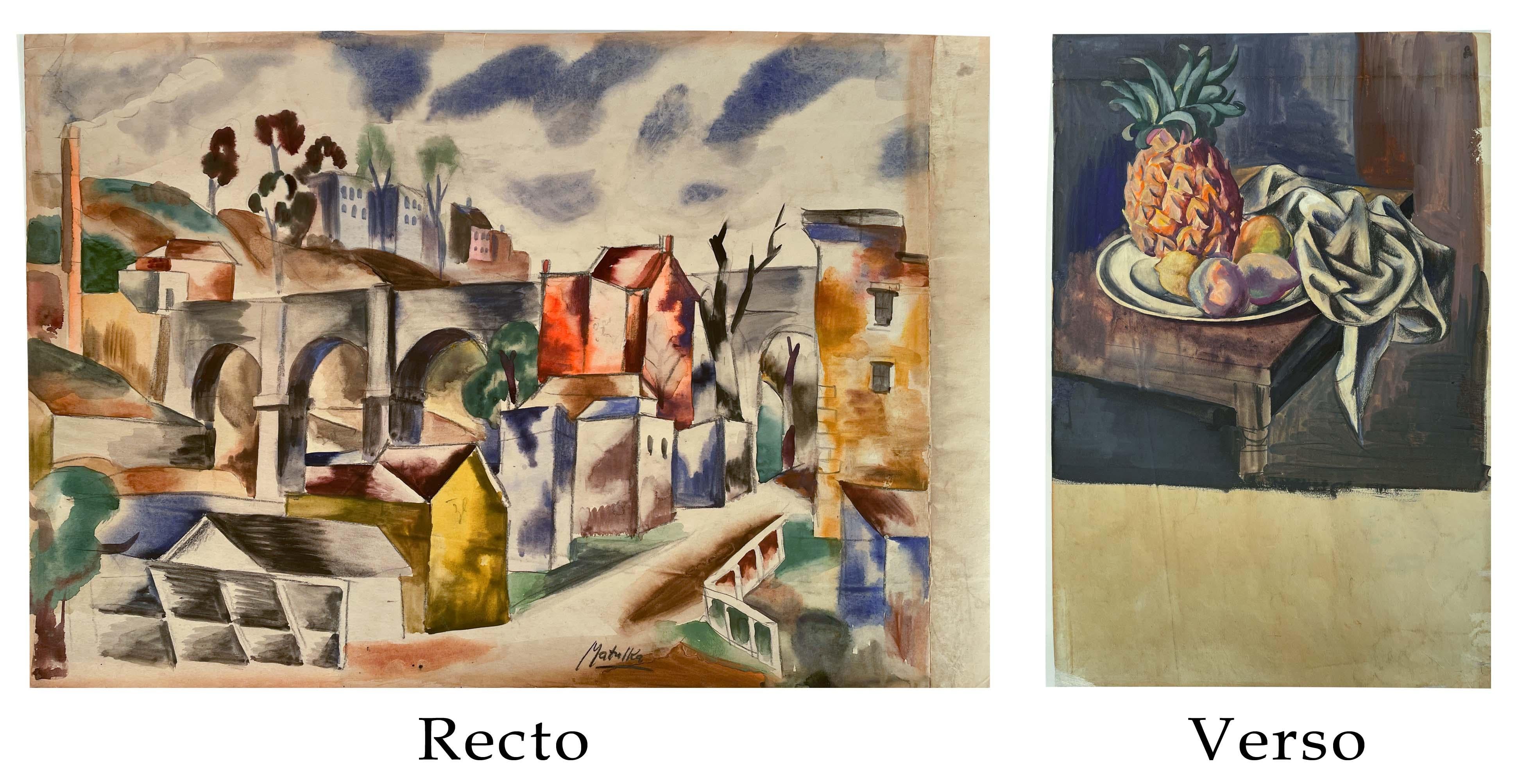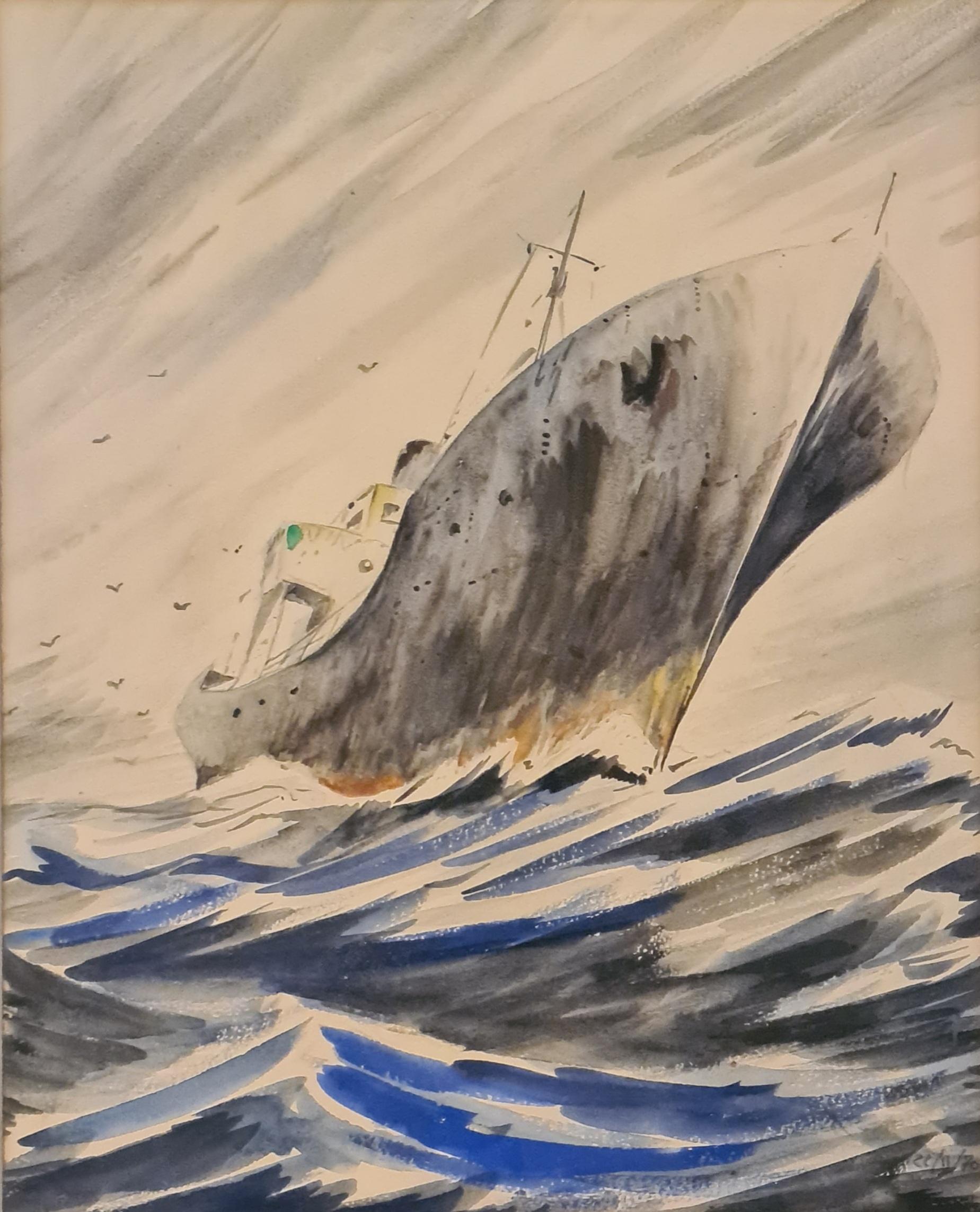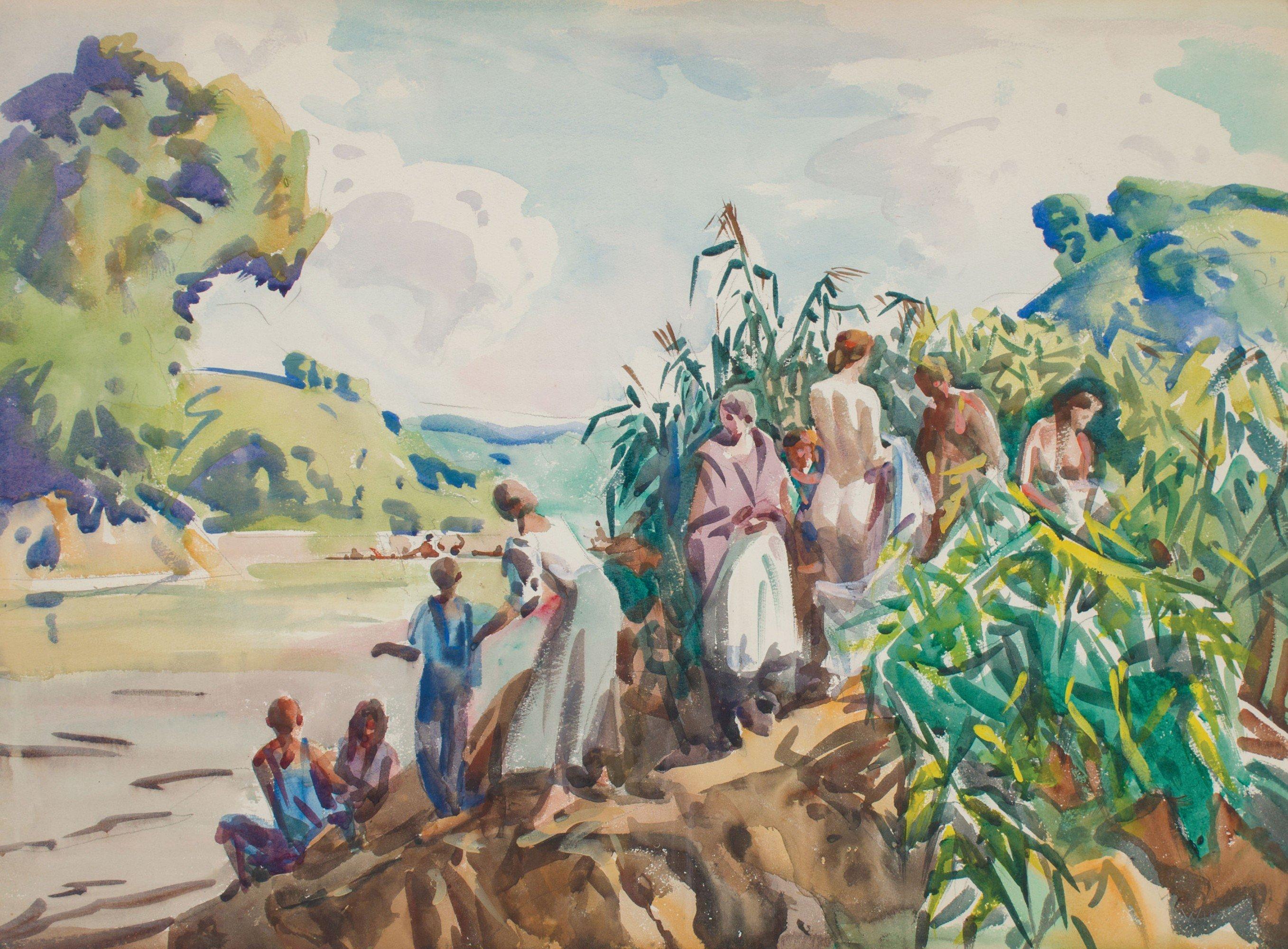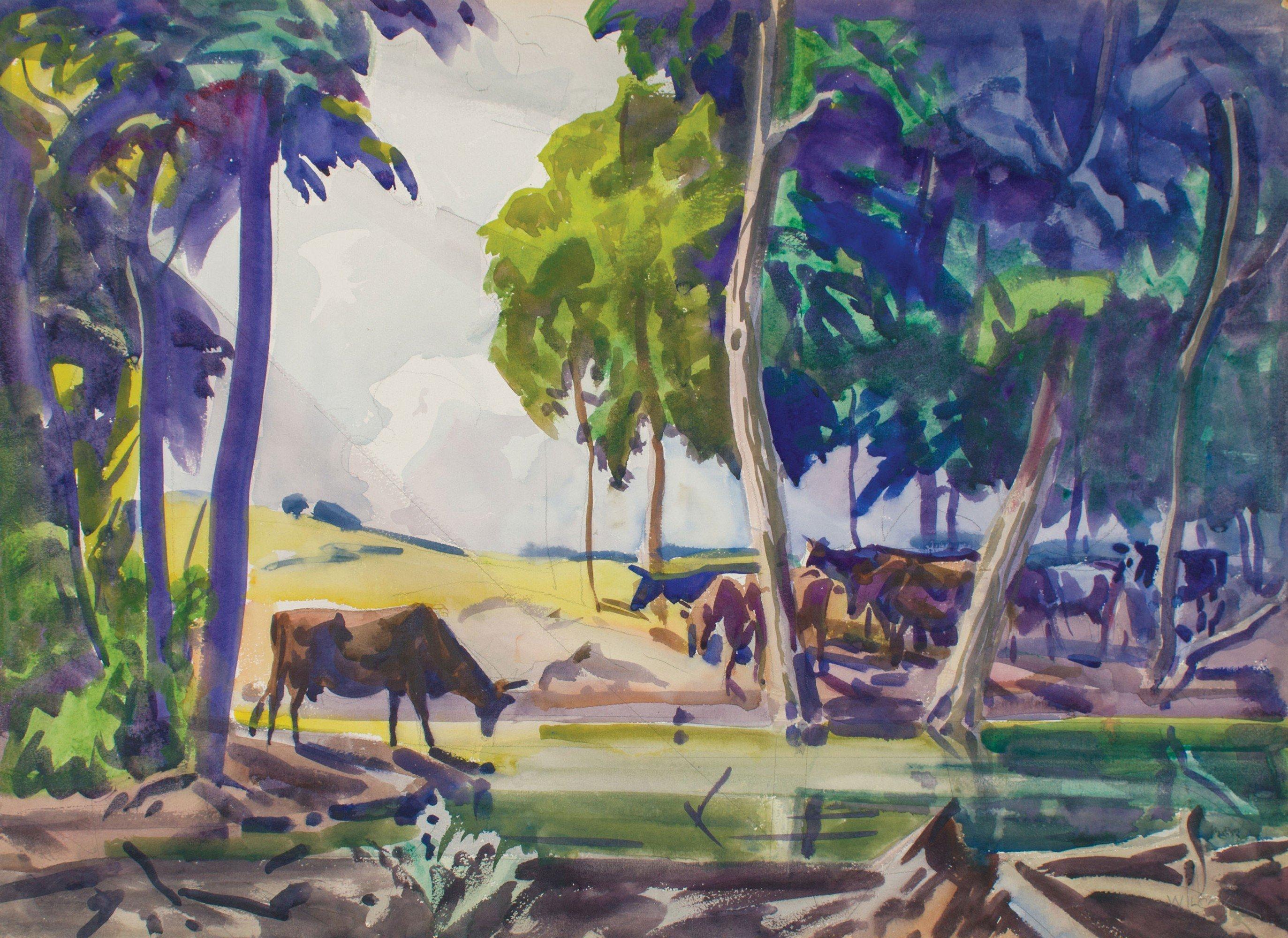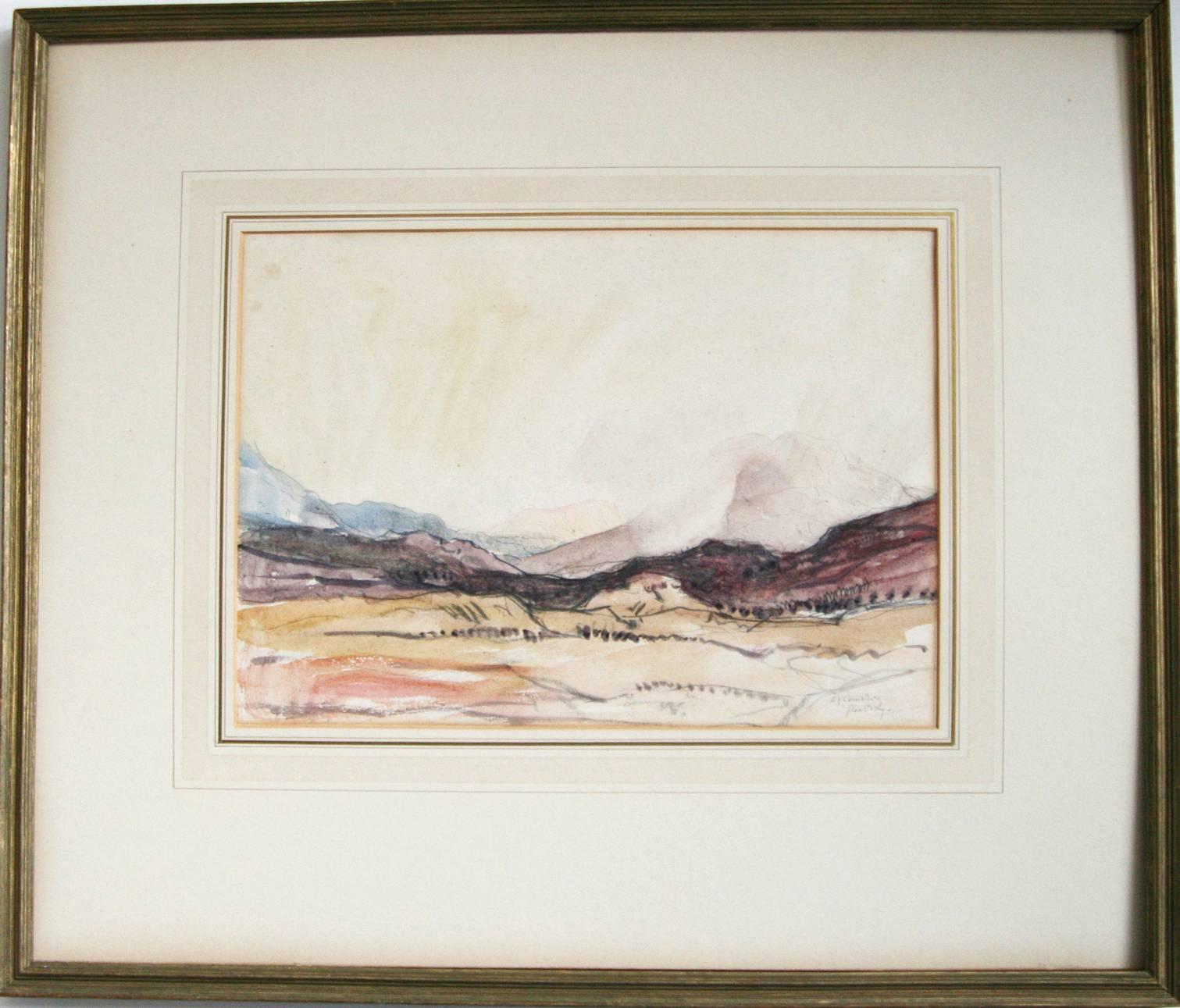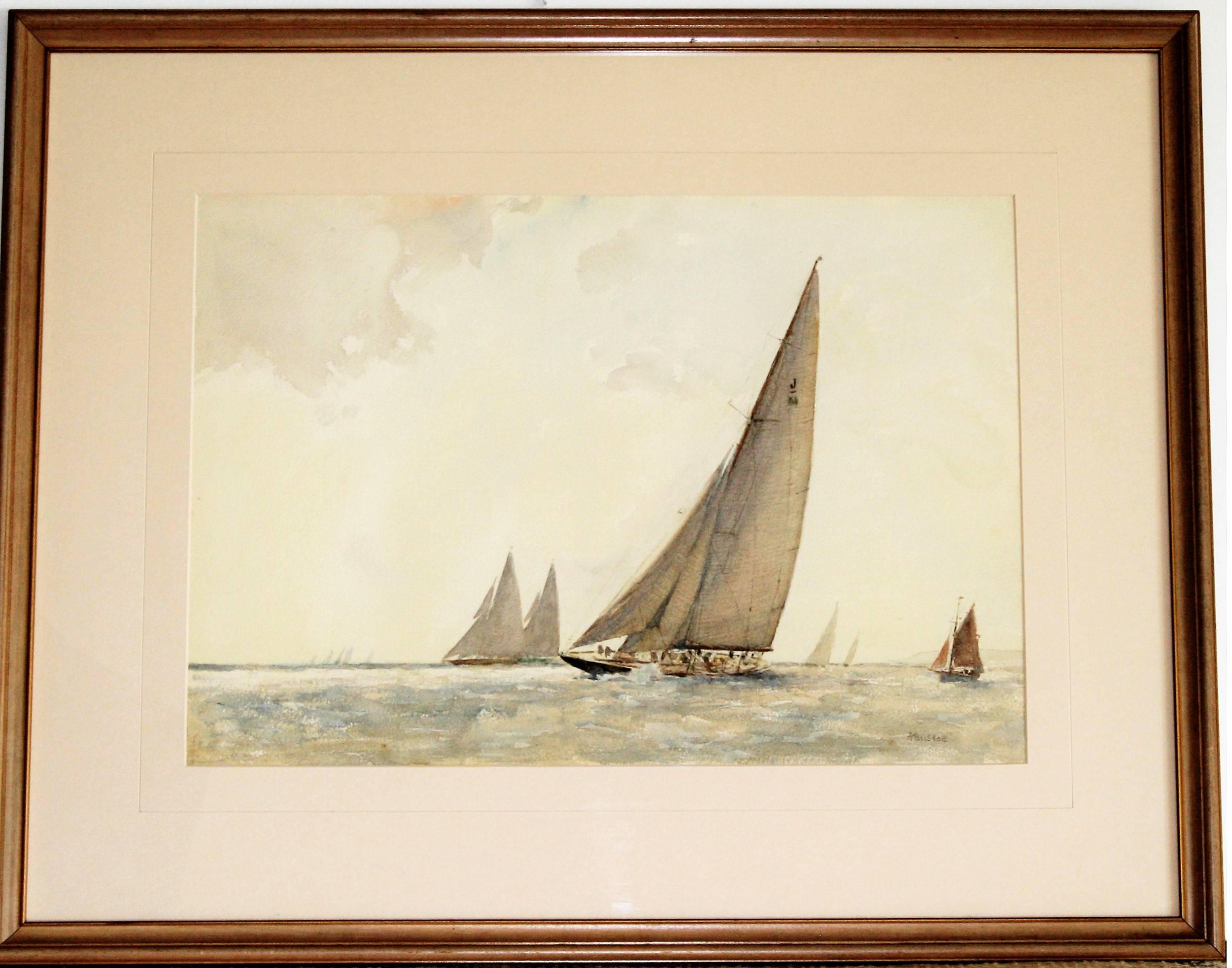Items Similar to Wilhelmina Barns-Graham 20th century watercolour of Monreale, Sicily
Want more images or videos?
Request additional images or videos from the seller
1 of 10
Wilhelmina Barns-GrahamWilhelmina Barns-Graham 20th century watercolour of Monreale, Sicily1955
1955
About the Item
Wilhelmina Barns-Graham (1912-2004)
Monreale, Sicily (1955)
48 x 58 cm
Pencil and wash on paper
Provenance: Barns-Graham Charitable Trust, authentication no 1665.
A heady evocation of summer in Sicily, characterised by burnt oranges and yellows.
Wilhelmina Barns-Graham, known as Willie, was born in St Andrews, Fife, on 8 June 1912. Her parents were second cousins, and their respective families were well established representatives of minor Scottish gentry from both the east and west of the country. As a child, Barns-Graham showed very early signs of creative ability. It was at school that Wilhelmina decided that she wanted to be an artist, stating later in life that "painting chose me, not I it".
After school she set her sights on Edinburgh College of Art where, after some dispute with her father (who was an emotional man prone to uncontrolled anger), she enrolled in 1931. During her time at Edinburgh College, Barns-Graham was taught by tutors including portrait painter David Alison and painter William MacTaggart. Her friends there included the influential Scottish painters Robert MacBryde, Robert Colquhoun, and William Gear.
After her education, Barns-Graham made study trips to Paris, London, and St Tropez before moving to St Ives, Cornwall, in 1940 (at the suggestion of the Edinburgh College of Art's Principal Hubert Wellington). Barns-Graham moved near to where a group of modernist artists had settled, at Carbis Bay - this was a pivotal moment in her life. On one of her first evenings there she met the sculptor Barbara Hepworth, who made an immediate and lasting impression on her. She then went on to meet Borlase Smart, Alfred Wallis, and Bernard Leach, as well as the painter Ben Nicholson and the sculptors Naum Gabo and Margaret Mellis. After two weeks in St Ives, Barns-Graham acquired her first studio, directly below the Porthmeor Gallery which was the administrative headquarters of the St Ives Society of Artists. Her paintings at the time were heavily influenced by the Cornish landscapes and the St Ives harbour. During 1940 and 1941, Barns-Graham contributed to the war effort by volunteering in a factory making camouflage nets.
In 1942 Barns-Graham became a member of the Newlyn Society of Artists, in which she exhibited with every year, and the St Ives Society of Artists. Whilst establishing herself in St Ives, Barns-Graham also continued to send work back to Scotland for major exhibitions held there such as the Royal Scottish Academy's 117th Exhibition in 1943. The 1940s were an active time for the St Ives Society of Artists who received a number of invitations to send exhibitions and groups of works to galleries in the UK and abroad, Barns-Graham's work was always included in these as the Society's secretary, Borlase Smart, thought highly of her work.
Barns-Graham's first opportunity to exhibit in London came when her work was included in a group exhibition of six at the Redfern Gallery. This was due to the introduction and support of Patrick Heron, who had visited Barns-Graham's studio in St Ives and was excited by her work. Barns-Graham would later have her first one-person exhibition in London at Redfern in 1952.
After a few years of tension, Barns-Graham eventually left the St Ives Society of Artists in 1949, becoming one of the founding members of a new breakaway group named Penwith Society of Arts. The first Penwith Society exhibition opened in June 1949 to huge success - 2755 paying visitors came to see it.
- Creator:Wilhelmina Barns-Graham (1912 - 2004)
- Creation Year:1955
- Dimensions:Height: 18.9 in (48 cm)Width: 22.84 in (58 cm)
- Medium:
- Movement & Style:
- Period:
- Condition:Generally very good; short dark mark to top margin; framed.
- Gallery Location:London, GB
- Reference Number:1stDibs: LU795310884072
About the Seller
4.8
Gold Seller
These expertly vetted sellers are highly rated and consistently exceed customer expectations.
Established in 2014
1stDibs seller since 2017
282 sales on 1stDibs
Typical response time: <1 hour
- ShippingRetrieving quote...Ships From: London, United Kingdom
- Return PolicyA return for this item may be initiated within 14 days of delivery.
More From This SellerView All
- Barclays Bank 1964 architectural drawing. Design by JDM Harvey, London, EnglandBy John Dean Monroe HarveyLocated in London, GBJohn Dean Monroe Harvey (1895-1978) A design for Barclays Bank, Walthamstow, London, England, UK (1964) Gouache 41 x 60 cm Signed and dated 1964. A very fine architectural perspe...Category
1960s Modern Landscape Drawings and Watercolors
MaterialsGouache, Pencil
- JDM Harvey Garret Hostel Bridge & Trinity Hall College & River Cam CambridgeBy John Dean Monroe HarveyLocated in London, GBJohn Dean Monroe Harvey (1895-1978) Garret Hostel Bridge, Cambridge Watercolour and pencil 38 x 61 cm Signed and dated 1969, with label for Guy Morgan & Partners. The present Garret Hostel Bridge is at least the eighth bridge on this site which lies between Trinity and Trinity Hall...Category
1960s Modern Landscape Drawings and Watercolors
MaterialsWatercolor, Pencil
- Magdalen College Oxford watercolour by Fred Mayor (1865-1916)By Fred MayorLocated in London, GBFred Mayor (British, 1865-1916) Magdalen College, Oxford Watercolour and pencil 12x15" In this painting, Mayor catches Magdalen in his usual impressionistic style, with an effective...Category
Early 20th Century Modern Landscape Drawings and Watercolors
MaterialsWatercolor, Pencil
- Brasenose College, Oxford Dugald Sutherland MacColl Pencil and WashLocated in London, GBTo see our other views of Oxford and Cambridge , particularly suitable for wedding and graduation presents, scroll down to "More from this Seller" and below it click on "See all from this Seller" - or send us a message if you cannot find the view you want. Dugald Sutherland MacColl (1859-1948) Brasenose College, Oxford Pencil and Wash...Category
Early 20th Century Modern Landscape Drawings and Watercolors
MaterialsWatercolor, Pencil
- Edwin La Dell Emmanuel College Cambridge watercolour Mid Century Modern BritishBy Edwin La DellLocated in London, GBFor other views of Oxford and Cambridge please see our other stock. Edwin La Dell ARA (1914-1970) Emmanuel College Cambridge Signed Waterco...Category
1960s Modern Landscape Drawings and Watercolors
MaterialsWatercolor, Carbon Pencil
- Albert Moore: 30 Fenchurch Street, London, 1915 architectural watercolourLocated in London, GBTo see our other Architectural Drawings, scroll down to "More from this Seller" and below it click on "See all from this Seller" and then search. Albert Walter Moore (1874 – 1965) D...Category
1910s Modern Landscape Drawings and Watercolors
MaterialsWatercolor, Pencil
You May Also Like
- Recto: "Cubist City Scene" Verso: "Pineapple Still Life"By Jan MatulkaLocated in New York, NYRecto: ‘Cubist City Scene’ Verso: ‘Pineapple Still Life’ by Jan Matulka (1890-1972) Pencil, colored pencil, and watercolor on paper 14 ¼ x 27 ½ inches unfr...Category
20th Century Modern Landscape Drawings and Watercolors
MaterialsWatercolor, Pencil
- A Fishing Boat at Sea, Late Mid-Century Gouache on PaperLocated in Cotignac, FRFrench gouache on paper of a boat travelling the seas. The work is unsigned but dated 22/11/70. Presented in simple gilt frame with handcut mount. A really engaging and powerful painting. The artist has managed to capture the swell of the sea, the movement of the boat listing gently to one side, the slightly rusty hull, the moody sky filled with all the seagulls following behind, which suggests it might be a fishing boat. They have used a limited but strong colour palette, blues, blacks and greys and then just to highlight and catch the eye a splash of green to represent the starboard or right bow light.Category
1970s Modern Landscape Drawings and Watercolors
MaterialsWatercolor, Pencil, Gouache, Paper
- Women's Corner, Along the Cuyahoga River, Early 20th Century Cleveland SchoolBy Frank WilcoxLocated in Beachwood, OHFrank Nelson Wilcox (American, 1887-1964) Women's Corner, Along the Cuyahoga River, c. 1916 Watercolor and graphite on paper 21 x 29 inches Frank Nelson Wilcox (October 3, 1887 – April 17, 1964) was a modernist American artist and a master of watercolor. Wilcox is described as the "Dean of Cleveland School painters," though some sources give this appellation to Henry Keller or Frederick Gottwald. Wilcox was born on October 3, 1887 to Frank Nelson Wilcox, Sr. and Jessie Fremont Snow Wilcox at 61 Linwood Street in Cleveland, Ohio. His father, a prominent lawyer, died at home in 1904 shortly before Wilcox' 17th birthday. His brother, lawyer and publisher Owen N. Wilcox, was president of the Gates Legal Publishing Company or The Gates Press. His sister Ruth Wilcox was a respected librarian. In 1906 Wilcox enrolled from the Cleveland School of Art under the tutelage of Henry Keller, Louis Rorimer, and Frederick Gottwald. He also attended Keller's Berlin Heights summer school from 1909. After graduating in 1910, Wilcox traveled and studied in Europe, sometimes dropping by Académie Colarossi in the evening to sketch the model or the other students at their easels, where he was influenced by French impressionism. Wilcox was influenced by Keller's innovative watercolor techniques, and from 1910 to 1916 they experimented together with impressionism and post-impressionism. Wilcox soon developed his own signature style in the American Scene or Regionalist tradition of the early 20th century. He joined the Cleveland School of Art faculty in 1913. Among his students were Lawrence Edwin Blazey, Carl Gaertner, Paul Travis, and Charles E. Burchfield. Around this time Wilcox became associated with Cowan Pottery. In 1916 Wilcox married fellow artist Florence Bard, and they spent most of their honeymoon painting in Berlin Heights with Keller. They had one daughter, Mary. In 1918 he joined the Cleveland Society of Artists, a conservative counter to the Bohemian Kokoon Arts Club, and would later serve as its president. He also began teaching night school at the John Huntington Polytechnic Institute at this time, and taught briefly at Baldwin-Wallace College. Wilcox wrote and illustrated Ohio Indian Trails in 1933, which was favorably reviewed by the New York Times in 1934. This book was edited and reprinted in 1970 by William A. McGill. McGill also edited and reprinted Wilcox' Canals of the Old Northwest in 1969. Wilcox also wrote, illustrated, and published Weather Wisdom in 1949, a limited edition (50 copies) of twenty-four serigraphs (silk screen prints) accompanied by commentary "based upon familiar weather observations commonly made by people living in the country." Wilcox displayed over 250 works at Cleveland's annual May Show. He received numerous awards, including the Penton Medal for as The Omnibus, Paris (1920), Fish Tug on Lake Erie (1921), Blacksmith Shop (1922), and The Gravel Pit (1922). Other paintings include The Trailing Fog (1929), Under the Big Top (1930), and Ohio Landscape...Category
1910s American Modern Figurative Drawings and Watercolors
MaterialsGraphite, Watercolor
- Cows by Woodland Pond, Toledo, Ohio, Early 20th Century Cleveland SchoolBy Frank WilcoxLocated in Beachwood, OHFrank Nelson Wilcox (American, 1887-1964) Cows by Woodland Pond, Toledo, Ohio, c. 1920 Watercolor and graphite on board Signed lower right 22 x 30 inches Frank Nelson Wilcox (October 3, 1887 – April 17, 1964) was a modernist American artist and a master of watercolor. Wilcox is described as the "Dean of Cleveland School painters," though some sources give this appellation to Henry Keller or Frederick Gottwald. Wilcox was born on October 3, 1887 to Frank Nelson Wilcox, Sr. and Jessie Fremont Snow Wilcox at 61 Linwood Street in Cleveland, Ohio. His father, a prominent lawyer, died at home in 1904 shortly before Wilcox' 17th birthday. His brother, lawyer and publisher Owen N. Wilcox, was president of the Gates Legal Publishing Company or The Gates Press. His sister Ruth Wilcox was a respected librarian. In 1906 Wilcox enrolled from the Cleveland School of Art under the tutelage of Henry Keller, Louis Rorimer, and Frederick Gottwald. He also attended Keller's Berlin Heights summer school from 1909. After graduating in 1910, Wilcox traveled and studied in Europe, sometimes dropping by Académie Colarossi in the evening to sketch the model or the other students at their easels, where he was influenced by French impressionism. Wilcox was influenced by Keller's innovative watercolor techniques, and from 1910 to 1916 they experimented together with impressionism and post-impressionism. Wilcox soon developed his own signature style in the American Scene or Regionalist tradition of the early 20th century. He joined the Cleveland School of Art faculty in 1913. Among his students were Lawrence Edwin Blazey, Carl Gaertner, Paul Travis, and Charles E. Burchfield. Around this time Wilcox became associated with Cowan Pottery. In 1916 Wilcox married fellow artist Florence Bard, and they spent most of their honeymoon painting in Berlin Heights with Keller. They had one daughter, Mary. In 1918 he joined the Cleveland Society of Artists, a conservative counter to the Bohemian Kokoon Arts Club, and would later serve as its president. He also began teaching night school at the John Huntington Polytechnic Institute at this time, and taught briefly at Baldwin-Wallace College. Wilcox wrote and illustrated Ohio Indian Trails in 1933, which was favorably reviewed by the New York Times in 1934. This book was edited and reprinted in 1970 by William A. McGill. McGill also edited and reprinted Wilcox' Canals of the Old Northwest in 1969. Wilcox also wrote, illustrated, and published Weather Wisdom in 1949, a limited edition (50 copies) of twenty-four serigraphs (silk screen prints) accompanied by commentary "based upon familiar weather observations commonly made by people living in the country." Wilcox displayed over 250 works at Cleveland's annual May Show. He received numerous awards, including the Penton Medal for as The Omnibus, Paris (1920), Fish Tug on Lake Erie (1921), Blacksmith Shop (1922), and The Gravel Pit (1922). Other paintings include The Trailing Fog (1929), Under the Big Top (1930), and Ohio Landscape...Category
1920s American Modern Figurative Drawings and Watercolors
MaterialsWatercolor, Graphite
- Glen Orchy.By David Young CameronLocated in Storrs, CTGlen Orchy. c. 1925. Watercolor, pencil and conte crayon on paper. 9 1/4 x 13 (sheet 10 3/8 x 13 1/4). Ex-collection L.G. Duke,purchased at Sotheby's, London '10.12.70'. Mat line; ot...Category
20th Century Modern Landscape Drawings and Watercolors
MaterialsWatercolor, Pencil
- The Endeavour.By Arthur John Trevor BriscoeLocated in Storrs, CTThe Endeavour. c.1935. Pencil and watercolor on watercolor board. 14 3/8 x 20 7/8. Signed in pencil, lower right; titled in pencil, verso. Housed in a subtle 23 1/2 x 36-inch light ...Category
1930s Modern Landscape Drawings and Watercolors
MaterialsPencil, Watercolor
